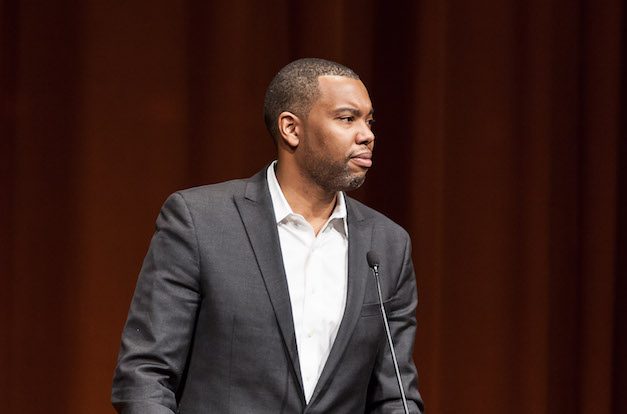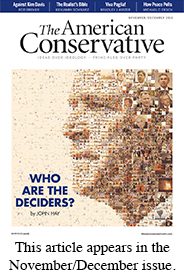The Hopeless Politics of Ta-Nehisi Coates

To understand the critical acclaim of Ta-Nehisi Coates’s extended essay on race in America and my review of it, recall the combative exchange that took place in 1963 between the black writer Ralph Ellison and Irving Howe, editor of the magazine Dissent. Ellison takes Howe, and white liberals in general, to task for believing that black Americans’ racial predicament is so forlorn that the only path for the authentically black intellectual is to protest and agitate constantly. Commenting on the effects of such myopic beliefs, Ellison suggests that there is not much difference between a white liberal and a segregationist:
Irving Howe would designate the role which Negro writers are to play more rigidly than any Southern politician—and for the best of reasons. We must express ‘black’ anger and ‘clenched militancy’; most of all we should not become too interested in the problems of the art of literature, even though it is through these that we seek our individual identities. And between writing well and being ideologically militant, we must choose militancy.
Coates’s argument is an updated version of Irving Howe’s, so much so that it seems to argue for segregation. As for the choice between writing well and ideological militancy, Coates and his liberal supporters prefer militancy.
Between the World and Me falls within the exhortative tradition of black American letter-writing, and Coates consciously modeled his essay on James Baldwin’s The Fire Next Time. Whereas Baldwin’s letter is addressed to his nephew, Coates’s letter is addressed to his 15-year-old son. The assumption behind Coates’s message is the debilitating belief that the racial circumstances he was born into nearly four decades ago are mostly the same today and have been inherited by his son. His introductory remarks capture the sentiment:
The destroyers [white people] are merely men enforcing the whims of our country, correctly interpreting its heritage and legacy. It is hard to face this. But all our phrasing—race relations, racial chasm, racial justice, racial profiling, white privilege, even white supremacy—serves to obscure that racism is a visceral experience, that it dislodges brains, blocks airways, rips muscle, extracts organs, cracks bones, breaks teeth. You must never look away from this. You must always remember that the sociology, the history, the economics, the graphs, the charts, the regressions all land, with great violence, upon the body.
Here we see Coates’ tendency to exaggerate for literary effect, which characterizes his entire essay.
The son of a Black Panther father and schoolteacher mother, Coates explains that when he was 15, he and all the other black people he knew in Baltimore “were powerfully, adamantly, dangerously afraid.” The fear manifested itself in the surly bravado that is often associated with ghetto culture—“rings and medallions,” playing the dozens, “puffy coats,” oversized T-shirts, rap music, and ritualized but violent street fighting. In the beatings he got from his father and the beatings his grandmother got from her father and the beatings administered by black mothers to save their girls from drugs and drug dealers—“guns, fists, knives, crack, rape, and disease”—fear was the culprit. Even in Philadelphia, where Coates’s extended family lived, fear was pervasive among his relatives. He accounts for the fear by explaining to his son that it stems from a “nakedness,” a vulnerability before the elements of the world: “The nakedness is not an error, nor pathology. The nakedness is the correct and intended result of policy, the predictable upshot of people forced for centuries to live under fear. The law did not protect us. And now, in your time, the law has become an excuse for stopping and frisking you, which is to say, for furthering the assault on your body.”
Coates’s emphasis on the black body and its vulnerability to the vestiges of white supremacy is disproportionate. There is no denying, as Orlando Patterson argues in Slavery and Social Death, that the bodily characteristics of slaves and their freed descendants, from ancient Athens to Jim Crow era America, were used as one of the justifications for their marginalization. Often their physical characteristics were associated with a threatening prowess—sexual, physical, or otherwise. Today, however, even beyond the success of the civil rights movement in demanding that blacks be treated equally before the law, the status of blacks and their cultural products has risen so much that even the most dysfunctional aspects of black culture have been embraced by various segments of the white community.
Coates exerts much effort to depict blacks as passive, innocent, and helpless, while he portrays whites as naïve but diabolical perpetrators. He glibly sets up a racial straw man for the sake of excusing the very real fear and physical threat he experienced while trying to survive in his black Baltimore neighborhood. The demands of survival, according to Coates, took the form of learning another “language consisting of a basic complement of head nods and handshakes.” Something as mundane as smiling, and whom one smiled at, carried symbolic significance in Coates’s neighborhood. A soft and unselfconscious demeanor was a sign of weakness in a black man, an invitation to physical altercations. Coates had to memorize certain blocks to be avoided, and developed a “smell and feel of fighting weather.” He refers to learning these survival skills as learning specific laws: “I recall learning these laws clearer than I recall learning my colors and shapes, because these laws were essential to the security of my body.”
 Unfortunately, the time spent learning the laws of survival was time not spent on, as Coates says, “the beautiful things.” His street knowledge came at the expense of book knowledge.
Unfortunately, the time spent learning the laws of survival was time not spent on, as Coates says, “the beautiful things.” His street knowledge came at the expense of book knowledge.
Coates’s honesty about the mental cost of trying to survive black ghetto culture is admirable, especially for someone as sensitive and intellectually inclined as he is. But in this part of the letter, his son would have benefited from an extended discussion of the emotional damage young black men do to themselves by adopting ghetto rules of behavior. Richard Majors, professor of psychology at University of Wisconsin at Eau Claire, called ghetto rules a “cool pose,” a type of speech and behavior that exaggerates masculinity. The studied indifference and aloof swagger of the pose stunts the emotional vocabulary of black males and makes it almost impossible for them to show vulnerability or a willingness to compromise in challenging situations.
The streets of Baltimore were not the only problem that conspired to limit Coates’s development; his primary and secondary schooling also did so: “If the streets shackled my right leg, the schools shackled my left leg. Fail to comprehend the streets and you give up your body now. But fail to comprehend the schools and you give up your body later. I suffered at the hands of both, but I resent the schools more.”
Why he resents the schools more is not exactly clear. It has something to do with the false morality in the “rote discipline” of the black body. The routines of his school days, such as walking in a single file, standardized testing, memorizing theorems, copying directions, were one big subterfuge. The real intent of our schools, according to Coates, is to lull Americans into forgetting that the American Dream rests on black bodies that are bloodied and broken.
Coates’s consciousness was awakened by the writings and speeches of Malcolm X and the provocative lyrics of the hip-hop artists who often quoted the slain black militant. The inspiration that Malcolm X offered to him in the early ’90s is palpable in his letter to his son. Malcolm X and others’ sayings and phrases, such as, “Don’t give up your life, preserve your life,” “If you’re black, you were born in jail,” and “black is beautiful,” were music to Coates’s ears. Spurred by the courage of Malcolm X and other black militants, he embarked on a journey of racial reclamation through his own study and exploration: “That was what I heard in the call to ‘keep it real.’ Perhaps we should return to ourselves, to our own primordial streets, to our own ruggedness, to our own rude hair. Perhaps we should return to Mecca.”
Coates refers to Howard University in particular as Mecca; several members of his family attended the school. He was admitted to the historically black college—although he eventually dropped out without getting a degree—and there he was introduced to a wide range of black people and black experiences. But whereas the perspective of the more nuanced writer would have been enlarged by Howard University’s cosmopolitan student body and faculty, Coates’s preoccupation with the black body and its discontents was made all the more provincial by his interest in mediocre, racist and fringy black writers. As for the non-fringy black writers he was introduced to at Howard—Zora Neale Hurston, Frederick Douglass, Stanley Crouch—he seems to have learned very little from them. Basically, the Coates that we get during his Howard University days is the Coates that we hear from today.
Between the World and Me is a disappointing read. It attempts to speak truth to power but instead speaks defeatism and a warped view of America to a son. One can only hope that Ta-Nehisi Coates’s son will outgrow his father’s shackles.
Andre Archie, professor of philosophy at Colorado State University, is the author of Politics in Socrates’ Alcibiades.
Comments